Reviewer's Note: The TLR sample was provided by DST for review. Please see their manufacturer's thread in CPFMP for more info.
Warning: pic heavy, as usual.
Manufacturer's specifications, summarized:

The review sample came in fairly basic packaging - a hard cardboard case with magnetic closing flap and foam inserts. Inside was the light with good quality clip attached (removable), extra screws and o-ring. There is no manual, but DST has sent me an instruction file when I inquired about how to use the light.




From left to right: Duracell alkaline AA, DST TLR, NiteCore EZAA, 4sevens MiNi AA Titanium, Titanium Innovations IlluminaTi, ThruNite TiKey
TLR: Weight 34.5g, Length 89.7mm, Width (bezel) 16.8mm
The TLR is remarkably thin for a 1xAA light (above, I'm showing the similarly thin EZAA and 4Sevens MiNi 1xAA Titanium for comparison above). Overall length is quite good considering it has a non-protruding clicky switch. This is about as small as I could expect for this class of light. oo:
oo:

Screw threads are reasonably good for a titanium light, although a certain amount of galling is to be expected. Finish is a little different from most titanium lights – the smooth areas have a polished finish, but the knurling/label areas have a burnished appearance. Even in the polished areas, overall appearance is more reminiscent of stainless steel lights (e.g. JetBeam E3) than most titanium ones. Identification labels are sharp and clear.
Note that the knurling is very fine (i.e. not highly raised, but with a lot of detail). This gives pretty good grip without being rough on material.
There is no tail/head lock-out on the TLR.
The stainless steel clip is solid, and firmly attached using two torx screws.

The reverse-clicky switch is slightly recessed, allowing the unit to tailstand. The switch has a stylish metal button cover, and the traverse feels a little longer than typical for a light this size. The closest comparable in appearance and feel that I can think of is the stainless steel JetBeam E3P (although that unit is far more bulky – the TLR feel much more refined).

Look familiar? The E3P is on the left in the pic above, TLR is on the right.

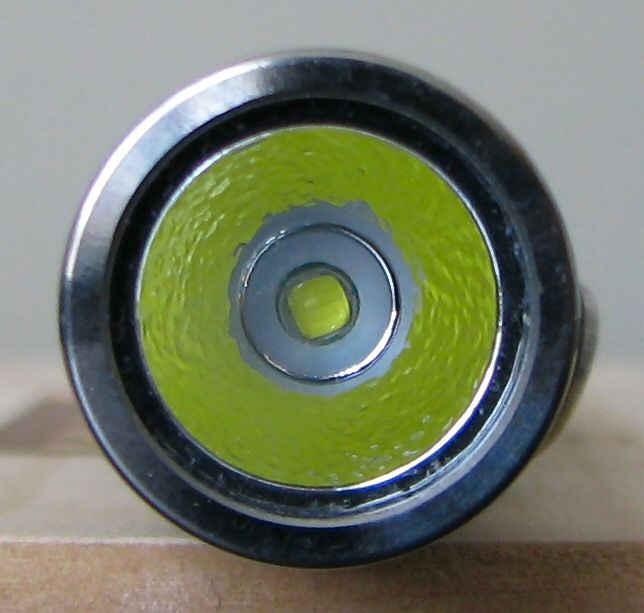
The TLR use the new high output XP-G R5-bin. The medium OP reflector is quite shallow, suggesting this light will be balanced more toward flood than throw. A nice aesthetic touch – a plastic disc has been placed around the emitter to hide the circuit board.
And now for the requisite white wall hunting … all lights are on Max on a Sanyo Eneloop AA, about 0.5 meters from a white wall.
… all lights are on Max on a Sanyo Eneloop AA, about 0.5 meters from a white wall.
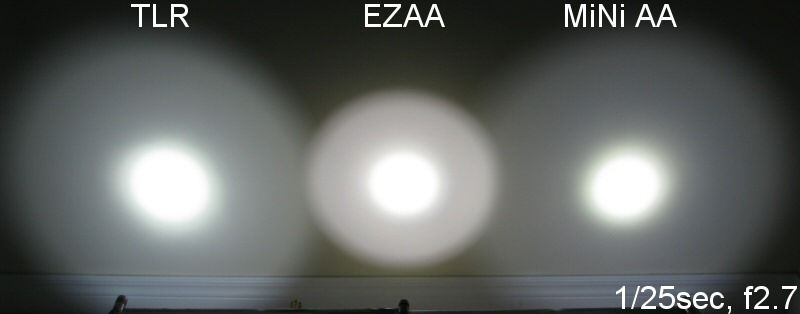
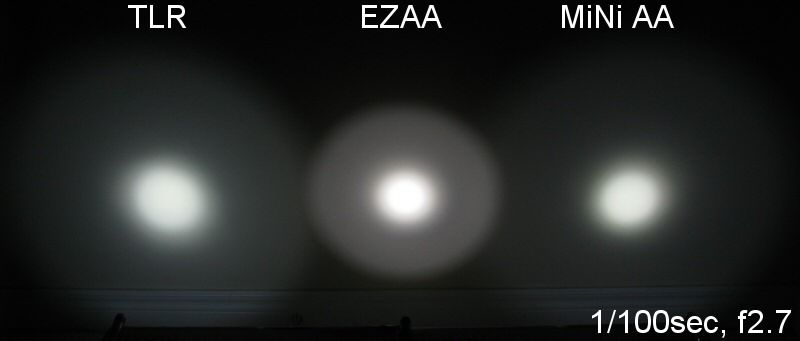

No tint bin is specified, but XP-Gs are known to often have a slightly greenish cool white tint. My TLR sample is no exception, and I am personally fine with this tint. For those of you not familiar with tint bins, please see my Colour tint comparison and the summary LED tint charts found here.
Beam pattern is indeed rather floody (i.e. not a very pronounced hotspot, plus a wide spillbeam). In fact, the beam pattern is very similar to the XP-G-equipped 4Sevens MiNi AA that I will be reviewing shortly.
To compare the TLR to a wider range of lights, scroll down for the output summary table.
User Interface
For once on a new light, this part is easy – the user interface and circuit functions are virtually identical to the original reverse-clicky JetBeam IBS interface! :huh:
Like the early IBS lights, there are 3 defined output states (A, B, and C) that you can set independently. The circuit features a continuously variable brightness mechanism, as well as a wide-range of strobe/SOS frequencies and intensities.
Mode Switching
Similar to JetBeam IBS, the default settings for the three modes are: A Med-High brightness, B Low-Med brightness, and C strobe (but these can all be easily re-assigned).
There is no memory mode - when switched on each time, the light enters mode A. Lightly soft- press the tail cap button (i.e. quick flash), and the light will go from mode A > B > C in cycle.
Changing the Set Levels
While on in any given mode, lightly soft-press the tail cap button three or more times within one second to enter the "Brightness Setting" mode. Here, the light will ramp in brightness from Min to Max gradually, flickering twice at 50% and three times at 100%. Once it reaches Max, the light then starts over at Min and repeats the process. Simply turn off the light to select the output level you want. It will then retain this setting the next time you turn the light back on.
Here's how the ramp compares to other lights:


Notice a strong resemblance to the original JetBeam Jet-I PRO IBS?
Special Functions Mode
While in the "Brightness Setting" lightly soft-press the tail cap button once more, and the light enters the "Special Functions" mode - which goes from 1HZ to 15HZ strobe, warning signal (locator), standby signal (beacon), 100% SOS and 5% SOS (sound familiar? Again, exactly the same as the original IBS). If you want to select any of these functions, just turn off the light and it will be set for the next time you turn on.
Here are a couple of traces of the Special Functions modes:


Reset Function
From the "Special Functions" mode, lightly soft-press the tail cap button once and the light enters Reset mode. Turn the light off, and when it comes back on you will be in the factory set default A, B, C settings.
My only comment here is that I find it somewhat harder to consistently flash the switch 3 times within one second on the TLR, compared to most JetBeam lights. I think this is due to the switch feel (i.e. the metal cover introduces a relative lag sensation). I found I was frequently advancing to the next mode, and accidentally setting the brightness there. :shrug:
PWM
Like the original IBS lights, I was unable to detect the PWM frequency in my setup (which means it must over ~30kHz, which is my upper detection limit). In his detailed review, HKJ reports a 52kHz freq on his TLR sample. Not to worry – you certainly won't be able to detect it in practice!
Testing Method: All my output numbers are relative for my home-made light box setup, a la Quickbeam's flashlightreviews.com method. You can directly compare all my relative output values from different reviews - i.e. an output value of "10" in one graph is the same as "10" in another. All runtimes are done under a cooling fan, except for the extended run Lo/Min modes (i.e. >12 hours) which are done without cooling.
Throw values are the square-root of lux measurements taken at 1 meter from the lens, using a light meter.
Throw/Output Summary Chart:


The TLR is clearly well driven on standard batteries – as the first R5-equipped AA light I've tested, Max overall output on NiMH exceeds anything else in my collection at present. oo: Max output 14500 is reasonable, but clearly not as highly driven as some of my other lights.
oo: Max output 14500 is reasonable, but clearly not as highly driven as some of my other lights.
As expected from the small and shallow reflector, centre-beam throw is at the relatively low end for this class of light.
Output/Runtime Comparison:


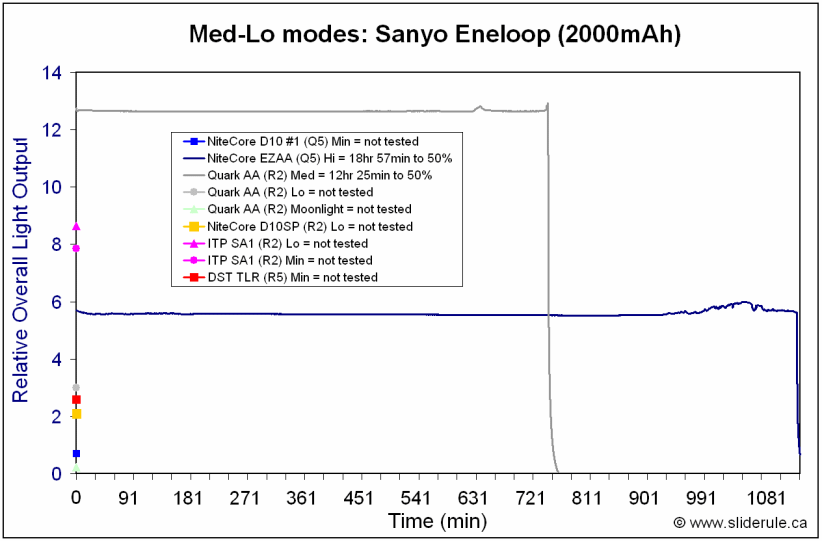
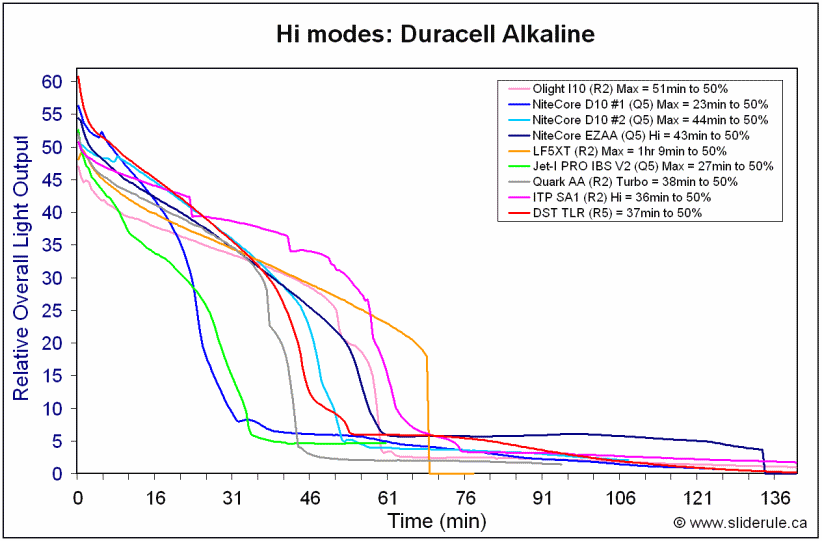



Again, not to , but the output/runtime pattern is exactly what I would expect from a R5-equipped IBS light ….
, but the output/runtime pattern is exactly what I would expect from a R5-equipped IBS light ….
Potential Issues
The switch has a slightly different feel from most, likely due to the metal switch button cover (i.e. there can be a bit of a lag when you press on the cover before you actually engage the switch). The feel is most like the JetBeam E3P (which bears a striking similar button appearance ). As a result, I found it difficult to consistently engage the brightness setting mode for any given output state, although it did work fine for switching between modes.
). As a result, I found it difficult to consistently engage the brightness setting mode for any given output state, although it did work fine for switching between modes.
As with all titanium lights, some degree of galling is to be expected with the screw threads (i.e. a sticking/binding sensation). My TLR sample is better than some I have experienced.
Preliminary Observations
I will cut right to the chase – those looking for a slim titanium 1xAA light with the original JetBeam IBS circuit, coupled with the latest R5 single-die emitter, look no further!

I don't generally like to speculate about the relationships between companies, but the similarities are just too remarkable to ignore here. No doubt about it – that's the original IBS circuit (or as close a copy as is humanly possible!).
Interestingly, there are also a few features of the bulkier stainless steel JetBeam E3P that have found their way in here (i.e. the tailcap/switch area, and overall finish of the smooth sections). :thinking: But the DST TLR is a far superior build to the E3P, with its slim-lined titanium design, enhanced grip (without rough edges), good clip, etc.
Personally, I quite like the titanium build – very solid, yet remarkably slim. :thumbsup: Good grip as well. While not as showy as some titanium lights, this one feels very functional. The only thing not well suited to the IBS interface is the switch – due to the metal button cover, it can be hard to reliably flash 3 times in one second (i.e. either it doesn't register the press, or you accidentally click off). But once you have it set the way you want, the switch works well to move between modes.
AFAIK, this sample is from a limited run. I am not familiar with DST's long-term plans, so I suggest you check out their CPFMP thread for more info.
Warning: pic heavy, as usual.
Manufacturer's specifications, summarized:
- LED:CREE XP-G (R5 bin)
- Max output:220 Lumens
- Continuously-variable circuit, with 3 programmable modes (includes hidden strobe/SOS/beacon modes)
- Reflector: OP metal reflector
- Lens: shock-resistant, coated mineral glass
- Material:Titanium alloy TC4
- Clip material:303 stainless steel
- Batteries: one AA battery or any other battery with same size
- Drive circuit:high efficiency wide voltage full tune-up circuit
- Voltage:0.7-4.2V
- Waterproof:meets IPX 8 waterproof standards
- Battery reverse protection function
- Safety lock-out function
- Tail stand and head stand capable
- Size:diameter:16.6mm Total length:89mm
- Weight: only 32g(without battery installed)
- Output & Runtime:
- Using 1 AA battery:about 135 Lumens(Max) for 70 minutes, about 2 Lumens(Min) for 50 hours
- Using 1 rechargeable Li battery:about 220 Lumens(Max)for 45 minutes, about 2 Lumens(Min) for 60 hours
- MSRP: $139 USD

The review sample came in fairly basic packaging - a hard cardboard case with magnetic closing flap and foam inserts. Inside was the light with good quality clip attached (removable), extra screws and o-ring. There is no manual, but DST has sent me an instruction file when I inquired about how to use the light.




From left to right: Duracell alkaline AA, DST TLR, NiteCore EZAA, 4sevens MiNi AA Titanium, Titanium Innovations IlluminaTi, ThruNite TiKey
TLR: Weight 34.5g, Length 89.7mm, Width (bezel) 16.8mm
The TLR is remarkably thin for a 1xAA light (above, I'm showing the similarly thin EZAA and 4Sevens MiNi 1xAA Titanium for comparison above). Overall length is quite good considering it has a non-protruding clicky switch. This is about as small as I could expect for this class of light.

Screw threads are reasonably good for a titanium light, although a certain amount of galling is to be expected. Finish is a little different from most titanium lights – the smooth areas have a polished finish, but the knurling/label areas have a burnished appearance. Even in the polished areas, overall appearance is more reminiscent of stainless steel lights (e.g. JetBeam E3) than most titanium ones. Identification labels are sharp and clear.
Note that the knurling is very fine (i.e. not highly raised, but with a lot of detail). This gives pretty good grip without being rough on material.
There is no tail/head lock-out on the TLR.
The stainless steel clip is solid, and firmly attached using two torx screws.

The reverse-clicky switch is slightly recessed, allowing the unit to tailstand. The switch has a stylish metal button cover, and the traverse feels a little longer than typical for a light this size. The closest comparable in appearance and feel that I can think of is the stainless steel JetBeam E3P (although that unit is far more bulky – the TLR feel much more refined).

Look familiar? The E3P is on the left in the pic above, TLR is on the right.


The TLR use the new high output XP-G R5-bin. The medium OP reflector is quite shallow, suggesting this light will be balanced more toward flood than throw. A nice aesthetic touch – a plastic disc has been placed around the emitter to hide the circuit board.
And now for the requisite white wall hunting



No tint bin is specified, but XP-Gs are known to often have a slightly greenish cool white tint. My TLR sample is no exception, and I am personally fine with this tint. For those of you not familiar with tint bins, please see my Colour tint comparison and the summary LED tint charts found here.
Beam pattern is indeed rather floody (i.e. not a very pronounced hotspot, plus a wide spillbeam). In fact, the beam pattern is very similar to the XP-G-equipped 4Sevens MiNi AA that I will be reviewing shortly.
To compare the TLR to a wider range of lights, scroll down for the output summary table.
User Interface
For once on a new light, this part is easy – the user interface and circuit functions are virtually identical to the original reverse-clicky JetBeam IBS interface! :huh:
Like the early IBS lights, there are 3 defined output states (A, B, and C) that you can set independently. The circuit features a continuously variable brightness mechanism, as well as a wide-range of strobe/SOS frequencies and intensities.
Mode Switching
Similar to JetBeam IBS, the default settings for the three modes are: A Med-High brightness, B Low-Med brightness, and C strobe (but these can all be easily re-assigned).
There is no memory mode - when switched on each time, the light enters mode A. Lightly soft- press the tail cap button (i.e. quick flash), and the light will go from mode A > B > C in cycle.
Changing the Set Levels
While on in any given mode, lightly soft-press the tail cap button three or more times within one second to enter the "Brightness Setting" mode. Here, the light will ramp in brightness from Min to Max gradually, flickering twice at 50% and three times at 100%. Once it reaches Max, the light then starts over at Min and repeats the process. Simply turn off the light to select the output level you want. It will then retain this setting the next time you turn the light back on.
Here's how the ramp compares to other lights:


Notice a strong resemblance to the original JetBeam Jet-I PRO IBS?
Special Functions Mode
While in the "Brightness Setting" lightly soft-press the tail cap button once more, and the light enters the "Special Functions" mode - which goes from 1HZ to 15HZ strobe, warning signal (locator), standby signal (beacon), 100% SOS and 5% SOS (sound familiar? Again, exactly the same as the original IBS). If you want to select any of these functions, just turn off the light and it will be set for the next time you turn on.
Here are a couple of traces of the Special Functions modes:


Reset Function
From the "Special Functions" mode, lightly soft-press the tail cap button once and the light enters Reset mode. Turn the light off, and when it comes back on you will be in the factory set default A, B, C settings.
My only comment here is that I find it somewhat harder to consistently flash the switch 3 times within one second on the TLR, compared to most JetBeam lights. I think this is due to the switch feel (i.e. the metal cover introduces a relative lag sensation). I found I was frequently advancing to the next mode, and accidentally setting the brightness there. :shrug:
PWM
Like the original IBS lights, I was unable to detect the PWM frequency in my setup (which means it must over ~30kHz, which is my upper detection limit). In his detailed review, HKJ reports a 52kHz freq on his TLR sample. Not to worry – you certainly won't be able to detect it in practice!
Testing Method: All my output numbers are relative for my home-made light box setup, a la Quickbeam's flashlightreviews.com method. You can directly compare all my relative output values from different reviews - i.e. an output value of "10" in one graph is the same as "10" in another. All runtimes are done under a cooling fan, except for the extended run Lo/Min modes (i.e. >12 hours) which are done without cooling.
Throw values are the square-root of lux measurements taken at 1 meter from the lens, using a light meter.
Throw/Output Summary Chart:


The TLR is clearly well driven on standard batteries – as the first R5-equipped AA light I've tested, Max overall output on NiMH exceeds anything else in my collection at present.
As expected from the small and shallow reflector, centre-beam throw is at the relatively low end for this class of light.
Output/Runtime Comparison:







Again, not to
 , but the output/runtime pattern is exactly what I would expect from a R5-equipped IBS light ….
, but the output/runtime pattern is exactly what I would expect from a R5-equipped IBS light …. Potential Issues
The switch has a slightly different feel from most, likely due to the metal switch button cover (i.e. there can be a bit of a lag when you press on the cover before you actually engage the switch). The feel is most like the JetBeam E3P (which bears a striking similar button appearance
As with all titanium lights, some degree of galling is to be expected with the screw threads (i.e. a sticking/binding sensation). My TLR sample is better than some I have experienced.
Preliminary Observations
I will cut right to the chase – those looking for a slim titanium 1xAA light with the original JetBeam IBS circuit, coupled with the latest R5 single-die emitter, look no further!

I don't generally like to speculate about the relationships between companies, but the similarities are just too remarkable to ignore here. No doubt about it – that's the original IBS circuit (or as close a copy as is humanly possible!).
Interestingly, there are also a few features of the bulkier stainless steel JetBeam E3P that have found their way in here (i.e. the tailcap/switch area, and overall finish of the smooth sections). :thinking: But the DST TLR is a far superior build to the E3P, with its slim-lined titanium design, enhanced grip (without rough edges), good clip, etc.
Personally, I quite like the titanium build – very solid, yet remarkably slim. :thumbsup: Good grip as well. While not as showy as some titanium lights, this one feels very functional. The only thing not well suited to the IBS interface is the switch – due to the metal button cover, it can be hard to reliably flash 3 times in one second (i.e. either it doesn't register the press, or you accidentally click off). But once you have it set the way you want, the switch works well to move between modes.
AFAIK, this sample is from a limited run. I am not familiar with DST's long-term plans, so I suggest you check out their CPFMP thread for more info.


